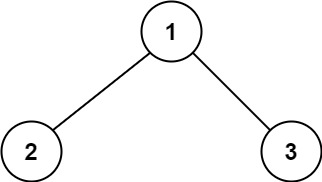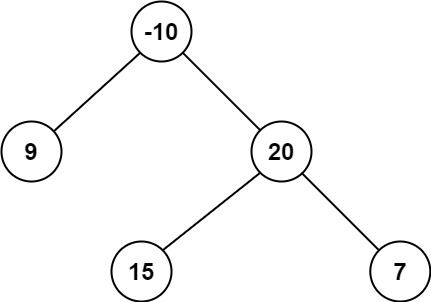# 二叉树中的最大路径和
路径 被定义为一条从树中任意节点出发,沿父节点-子节点连接,达到任意节点的序列。同一个节点在一条路径序列中 至多出现一次 。该路径 至少包含一个 节点,且不一定经过根节点。
路径和 是路径中各节点值的总和。
给你一个二叉树的根节点 root ,返回其 最大路径和 。
示例 1:

输入:root = [1,2,3]
输出:6
解释:最优路径是 2 -> 1 -> 3 ,路径和为 2 + 1 + 3 = 6
示例 2:

输入:root = [-10,9,20,null,null,15,7]
输出:42
解释:最优路径是 15 -> 20 -> 7 ,路径和为 15 + 20 + 7 = 42
提示:
- 树中节点数目范围是
[1, 3 * 104]
-1000 <= Node.val <= 1000
## template
```cpp
#include
using namespace std;
struct TreeNode
{
int val;
TreeNode *left;
TreeNode *right;
TreeNode(int x) : val(x), left(NULL), right(NULL) {}
};
class Solution
{
public:
int maxPathSum(TreeNode *root)
{
if (!root)
return 0;
vector ss;
unordered_map val;
ss.push_back(root);
int len = 1;
queue q{{root}};
while (!q.empty())
{
TreeNode *t = q.front();
q.pop();
cout << t->val << endl;
if (t->left)
{
len++;
q.push(t->left);
ss.push_back(t->left);
}
if (t->right)
{
len++;
q.push(t->right);
ss.push_back(t->right);
}
}
int res = INT_MIN;
while (len > 0)
{
TreeNode *node = ss[--len];
int ps = node->val;
int s = ps;
int ls = max(0, val[node->left]);
int rs = max(0, val[node->right]);
ps += max(ls, rs);
val[node] = ps;
s += ls + rs;
res = max(s, res);
}
return res;
}
};
```
## 答案
```cpp
```
## 选项
### A
```cpp
```
### B
```cpp
```
### C
```cpp
``` 
